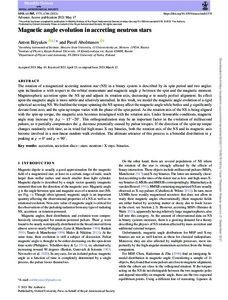Magnetic angle evolution in accreting neutron stars
Biryukov Anton; Abolmasov Pavel
https://urn.fi/URN:NBN:fi-fe2021093047931
Tiivistelmä
The rotation of a magnetized accreting neutron star (NS) in a binary system is described by its spin period and two angles: spin inclination alpha with respect to the orbital momentum and magnetic angle chi between the spin and the magnetic moment. Magnetospheric accretion spins the NS up and adjusts its rotation axis, decreasing alpha to nearly perfect alignment. Its effect upon the magnetic angle is more subtle and relatively unstudied. In this work, we model the magnetic angle evolution of a rigid spherical accreting NS. We find that the torque spinning the NS up may affect the magnetic angle while both alpha and chi significantly deviate from zero, and the spin-up torque varies with the phase of the spin period. As the rotation axis of the NS is being aligned with the spin-up torque, the magnetic axis becomes misaligned with the rotation axis. Under favourable conditions, magnetic angle may increase by Delta chi similar to 15 degrees-20 degrees. This orthogonalization may be an important factor in the evolution of millisecond pulsars, as it partially compensates the chi decrease potentially caused by pulsar torques. If the direction of the spin-up torque changes randomly with time, as in wind-fed high-mass X-ray binaries, both the rotation axis of the NS and its magnetic axis become involved in a non-linear random-walk evolution. The ultimate attractor of this process is a bimodal distribution in chi peaking at chi = 0 degrees and chi = 90 degrees.
Kokoelmat
- Rinnakkaistallenteet [27094]
